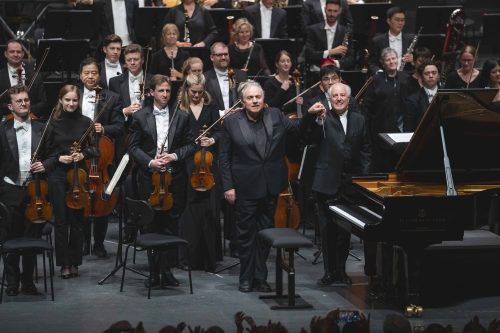 Austria Salzburg Festival 2024 [6] – Rachmaninov and Mahler: Yefim Bronfman (piano), Pittsburgh Symphony Orchestra / Manfred Honeck (conductor). Grosses Festspielhaus, Salzburg, 22.8.2024. (MB)
Austria Salzburg Festival 2024 [6] – Rachmaninov and Mahler: Yefim Bronfman (piano), Pittsburgh Symphony Orchestra / Manfred Honeck (conductor). Grosses Festspielhaus, Salzburg, 22.8.2024. (MB)

Rachmaninov – Piano Concerto No.3 in D minor, Op.30
Mahler – Symphony No.5
Rachmaninov’s music requires a tight formal command, especially for a work on the scale of the Third Piano Concerto, to dispel suspicions of the rhapsodic, or at least to ensure that rhapsodic qualities contribute to a sense of a greater whole. Yefim Bronfman and Manfred Honeck are very considerable musicians, yet in this performance, the first movement did not quite for me cohere as it might. Its conversational opening, understated yet on the move, compelled, as if ‘recalling’ music whose origin was lost in the mists of time. The performance was swift, perhaps a little too much at times, though that is surely preferable to lapsing into sentimentality; it enabled one to listen to often kaleidoscopic harmonies coming together thematically, especially in the piano part, though the second thematic group already sounded a little distended. The development section was nicely exploratory and the recapitulation had a proper sense of return; only some sense, at times, of quite why we moved from A to B was at times lacking. If the lack of heaviness was welcome, Bronfman bringing out passagework affinities with Prokofiev as well as Liszt, there were times when Honeck kept down the Pittsburgh Symphony a little too much.
The second and third movements redressed that relative imbalance, rhapsodic elements more properly integrated. Honeck and the orchestra were more willing to take the lead, strings properly allowed their head for the first time. When the excellent Pittsburgh brass had spells in the limelight, featuring more prominently in a richly protean finale, the temperature rose further. To some extent, I think this was a performance conception, an expression of trajectory; in retrospect, it seemed a pity that the greater urgency – as opposed to mere speed – could not have been read back into the first movement. The audience, though, disagreed, seemingly acclaiming the performance without reservation.

Mahler conducted the Rachmaninov concerto in New York in 1910, with the composer as soloist. It is difficult to think of any other obvious connection between the two works and also difficult to say the combination worked to Rachmaninov’s advantage. Nevertheless, the performance of Mahler’s Fifth Symphony experienced one major difficulty of its own, though not one for which the performers were in any way responsible. The opening promised excellent things, the Pittsburgh solo trumpet – as, subsequently, the brass section as a whole – spellbinding in his macabre opening solo. From the outset, this first movement sounded more grounded than its first-half counterpart, Honeck communicating a clearer sense of where it was heading. It felt like a funeral march, or rather set of obsequies, without in any sense being reduced to an implied programme. This was, as Mahler always insisted, music, not a musical rendering of something else.
A further strength of Honeck’s reading was his strong sense of the symphony’s division of five movements into three ‘parts’, the second movement very much following on from and necessitated by the first. Here, the generative role of rhythm came to the fore. If there were occasions when I wished the strings might dig deeper, there was nothing especially wrong with the playing. In such music, one often, however unfairly, recalls favoured performances or recordings of the past; such recollections can be tinged by unreliable romanticism and perhaps mine were too. Brass nonetheless seized the initiative for a thrilling first rendition of the chorale. A certain harshness at climaxes seemed to be deliberate. What, then, was the problem? A strange noise to be heard above the orchestra, both in pitch and seemingly in location. Although it sounded like a giant mouse, I assumed it must be some sort of electronic interference. I was closer initially; it transpired a bat had come to the party and was voicing its appreciation.
After a short pause in which the problem was somehow resolved, we heard a properly liminal, transitional Scherzo, its neo-Bachian counterpoint clear and directed. The Adagietto convinced similarly: a little slow by current, fashionable standards, but there is no one way to perform this music, in which fashion is as unwelcome as in Bach or Mozart. It is perhaps unsurprising, given Honeck’s pedigree as a string player, that we heard chamber music writ large. He handled the transition to the finale with as great skill as the connection between first and second movements, the fifth movement then proceeding with welcome hints of the sardonic. I wondered at times whether it was a little lacking in sheer abandon, but all came together perfectly for the chorale, whose advent and jubilant aftermath imparted sense to much of what had preceded them. I say ‘much’ only because the flying rodent’s disruption to my experience had been severe: a great pity. It was almost made up for, though, in a splendid encore performance of Ochs’s waltz from Der Rosenkavalier, rubato judged in echt Viennese fashion.
Mark Berry
